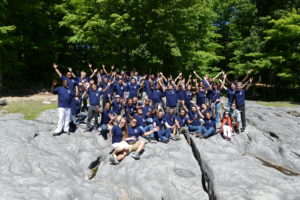A coach bus full of students began the journey to tour Adventist Historic sites in New York and New England from August 5 to 12, 2018. This is an annual event for students of the Seventh-day Adventist Theological Seminary. Many find it a way to connect with the roots of the Seventh-day Adventist church. Brian Seewaldt Rigoni reflected on his experience and said, “The tour…allowed me to see that the fire of the Spirit that the early SDA Church experienced is also available today.”
On Monday, in Rochester, New York, the students toured Mount Hope Cemetery to see the graves of Mary Andrews, Angeline Andrews, Carrie Andrews, Nathaniel White and Anna White, and Frederick Douglass. Afterward. the bus drove around the city to see historic sites, and then began the trip to Massachusetts. Lunch was served in the parking lot of a Walmart and headed toward the Erie Canal Museum. The group spent about an hour on a self-guided tour of the small museum and then were back on the road to Uncasville, CT for the night.
The following day the study tour went to Mystic Sea Port in Connecticut. The outdoor temperature was in the 90s and the humidity level was high. The group enjoyed seeing as much of the 1830s sea port village as the heat would allow. The staff of the village were very knowledgable and there was lots to see. Mystic Sea Port puts people into the mindset of life in the 1830s. That was a few years earlier than the events focused on during the tour, but a good place to start to get a feel for how daily life was lived for our Adventist pioneers. Next, the group was back in the bus and headed to sites related to Joseph Bates.
Joseph Bates, one of the co-founders of the Seventh-day Adventist church, grew up in Fairhaven, Massachusetts. His childhood home was near enough to the Atlantic to see the ocean-going vessels in the harbor and it is easy to understand how Bates developed a longing to go to sea. Bates spent 20-plus years at sea and retired as captain of his own ship with a comfortable fortune. The tour went to the home that he built upon his retirement which was later sold to fund the spread of the Millerite Advent message. Along the rocky water’s edge, where the old Fairhaven Bridge once stood, participants heard the story of how the Sabbath being the seventh day of the week came to the Millerites and to Joseph Bates. Bates then wrote three tracts on the Sabbath, one of which James and Ellen White read and were convinced to start keeping the seventh day of the week as the Sabbath.
Wednesday, the tour went to Maine; the house was pointed out where James and Ellen White were living when they accepted the Sabbath. This was in Gorham, Maine, while the Whites were living with Ellen’s parents in 1847. Gorham, Maine, is also where Ellen was born. She spent many of her growing up years in Portland, Maine. The tour visited many sites in Portland, but because of a fire in the 1860s and construction of newer buildings, many of the sites are uninspiring. For example, the spot where Ellen Harmon was baptized is now a parking lot because the city reclaimed land from the bay.
Thursday was spent in New Hampshire. First was a visit to the Washington, New Hampshire, Seventh-day Adventist church, which features the Sabbath Trail on its property. The group spent the morning in the church hearing stories and singing songs. After lunch, a walk along the Sabbath Trail and picture taking time, the tour moved on to the childhood home of Uriah Smith and his sister Annie Smith. The LaJoies, owners of the Smith tavern, opened their home for a tour. Everyone enjoyed seeing the restored tavern. Annie Smith’s grave is in a cemetery nearby, near her family members.
That evening, the group ate at the Country Life Restaurant in Keene, New Hampshire. This is an independent, Adventist owned, vegan restaurant. Many on the tour considered it to be the best meal of the trip. It was a learning experience for many who were not familiar with the health ministry of these restaurants. It served as an anchor for the lectures about the health message given to the Seventh-day Adventist Church.
Friday was spent at the William Miller Farm and chapel. Elder Jim Nix, president of the White Estate, joined us to present the story of William Miller in the chapel. With passion and exhortation he described Miller’s conversion. He held up a cannon ball as a visual aid in describing the war of 1812 and the battle in which Miller took part. Later Elder Nix presided over the tour through Miller’s home. Later on, a group photo was taken on Ascension Rock with everyone wearing the special t-shirts that were given to each participant again this year.
Sabbath morning the group was at the Roosevelt Seventh-day Adventist Church for the worship service and then Sabbath School. Dr. Burt spoke for the worship service. The church was again blessed to have the group. A very delicious lunch of vegan pulled pork sandwiches and salad, along with a dessert of homemade pies was served and pita pocket feast was prepared for a to-go supper. After a visit to the Roosavelt Cemetery, the bus was loaded to begin the frive to the Hiram Edson barn. After a meaningful visit to the barn, the group enjoyed the sack supper that the Roosevelt Church had provided. Then it was back to Rochester, NY for the night.
Sunday’s journey back to the University was uneventful; all were thankful for safe travels and even though the weather was estremely hot and humid for a lot of the time, God held back he rain through the whole week.

